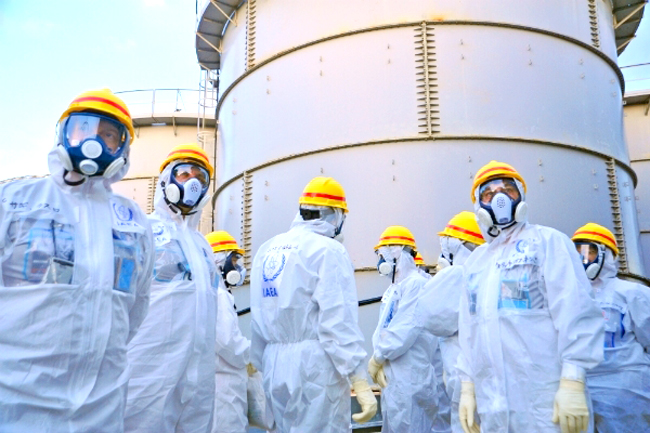Fukushima’s 4th Anniversary Brings Hope Amidst Radioactive Ruins as Renewable Energy Revolution Soars
ENERGY, 16 Mar 2015
Harvey Wasserman, EcoWatch – TRANSCEND Media Service
Fukushima’s Anniversary Should Remind Us Nuclear Power Poses Threat to Human Survival
11 Mar 2015 – The catastrophe that began at Fukushima four years ago today is worse than ever.
But the good news can ultimately transcend the bad—if we make it so.
An angry grassroots movement has kept shut all 54 reactors that once operated in Japan. It’s the largest on-going nuke closure in history. Big industrial windmills installed off the Fukushima coast are now thriving.

A team of IAEA experts check out water storage tanks TEPCO’s Fukushima Daiichi Nuclear Power Station on Nov. 27, 2013. The expert team is assessing Japanese efforts to decommission the stricken nuclear power plant. Photo Credit: Greg Webb / IAEA
Five U.S. reactors have shut since March 11, 2011. The operable fleet is under 100 for the first time in decades.
Ohio’s Davis-Besse, New York’s Ginna, five reactors in Illinois and other decrepit American nukes could shut soon without huge ratepayer bailouts.
Diablo Canyon was retrofitted—probably illegally—with $842 million in replacement parts untested for seismic impact. Already under fire for illegal license manipulations and an avoidable gas explosion that killed eight in San Bruno in 2010, Pacific Gas & Electric has plunged into a legal, economic and political abyss that could soon doom California’s last reactors.
Meanwhile, Germany is amping up its renewable energy generation with a goal of 80 percent or more by 2050.
France—once nuke power’s poster child—has turned away from new reactor construction and is moving strongly toward renewables.
Worldwide the Solartopian revolution is ahead of schedule and under budget. Predictions about its technological and economic potential are being everywhere exceeded.
More than twice as many Americans now work in solar as in coal mines. As the head of the Rockefeller Brothers Fund recently put it: “We are quite convinced that if John D Rockefeller were alive today, as an astute businessman looking out to the future, he would be moving out of fossil fuels and investing in clean, renewable energy.”
Even America’s Tea Party has developed a green wing promoting renewables.
Vital focus now centers on battery breakthroughs needed to escalate rooftop solar, electric cars and other post-nuke game-changers.
But there’s plenty of bad news. The State Secrets Act of Japan’s authoritarian Abe regime renders unreliable all “official” information from Fukushima. Grassroots nuclear campaigners are under serious attack.
At least 300 tons of radioactive water still pour daily into the Pacific Ocean. The utility wants to dump even more untreated outflow into currents that are already testing radioactive along the California coast. Details of fuel rod bring-downs and site clean-ups remain unknown.
Thyroid damage rates are soaring among downwind children. Abe is forcing evacuees back into areas that are seriously contaminated. Fukushima’s owner (Tepco) is the #1 money funnel to his Liberal Democratic Party, which flips untold billions back to the utility.
More than 128,000 petitioners asking that the world community take charge at Fukushima have been ignored by the United Nations since November, 2013.
Throughout the world decaying reactors threaten our survival. Ohio’s Davis-Besse containment is literally crumbling. Diablo Canyon is surrounded by 15 known fault lines, one just 700 yards from the cores. New reactor sites in Finland, France and Georgia show slipshod construction, substandard parts and corrupted supervision that would make them instant threats should they go on line.
Citizen activism challenges all that. Today Solartopian activists will picket Japanese consulates worldwide.
An evolving electricity boycott to “unplug nuclear” and a growing grassroots demand for green energy herald a new era of people power.
Four years after the endless Fukushima disaster began, that renewable revolution defines our survival.
It’s a fight we can’t afford to lose. It’s a victory we must soon embrace … with the utmost relief and joy.
____________________________
Harvey speaks and writes widely on energy, the environment, history, election protection and politics. He teaches history and cultural & ethnic diversity at two central Ohio colleges, and is married with five daughters and five grandchildren. He works for the permanent shutdown of the nuclear power industry and the birth of Solartopia, a democratic and socially just green-powered Earth free of all fossil and nuclear fuels.
DISCLAIMER: The statements, views and opinions expressed in pieces republished here are solely those of the authors and do not necessarily represent those of TMS. In accordance with title 17 U.S.C. section 107, this material is distributed without profit to those who have expressed a prior interest in receiving the included information for research and educational purposes. TMS has no affiliation whatsoever with the originator of this article nor is TMS endorsed or sponsored by the originator. “GO TO ORIGINAL” links are provided as a convenience to our readers and allow for verification of authenticity. However, as originating pages are often updated by their originating host sites, the versions posted may not match the versions our readers view when clicking the “GO TO ORIGINAL” links. This site contains copyrighted material the use of which has not always been specifically authorized by the copyright owner. We are making such material available in our efforts to advance understanding of environmental, political, human rights, economic, democracy, scientific, and social justice issues, etc. We believe this constitutes a ‘fair use’ of any such copyrighted material as provided for in section 107 of the US Copyright Law. In accordance with Title 17 U.S.C. Section 107, the material on this site is distributed without profit to those who have expressed a prior interest in receiving the included information for research and educational purposes. For more information go to: http://www.law.cornell.edu/uscode/17/107.shtml. If you wish to use copyrighted material from this site for purposes of your own that go beyond ‘fair use’, you must obtain permission from the copyright owner.